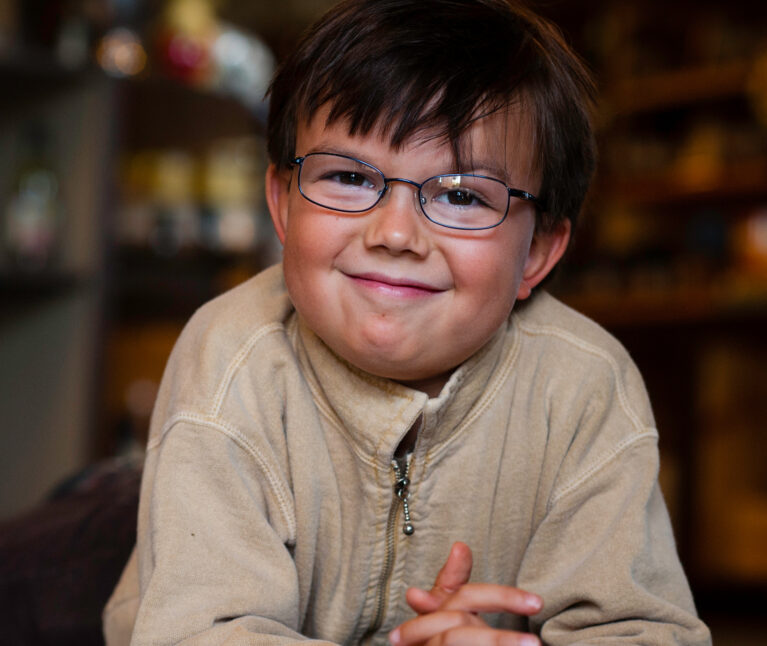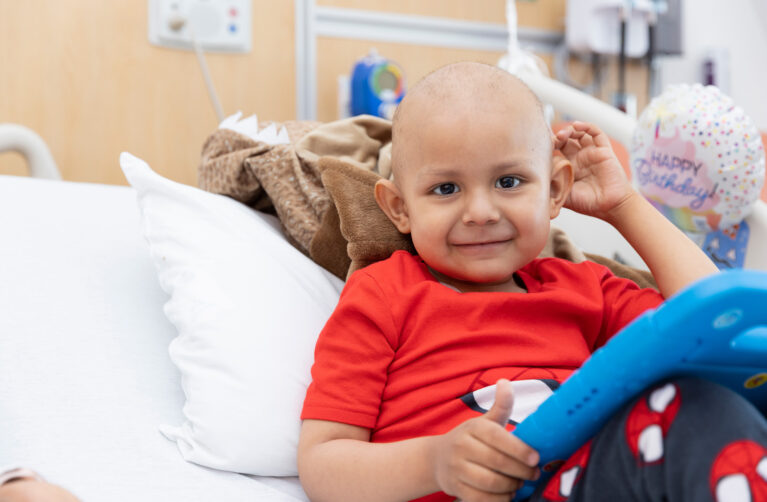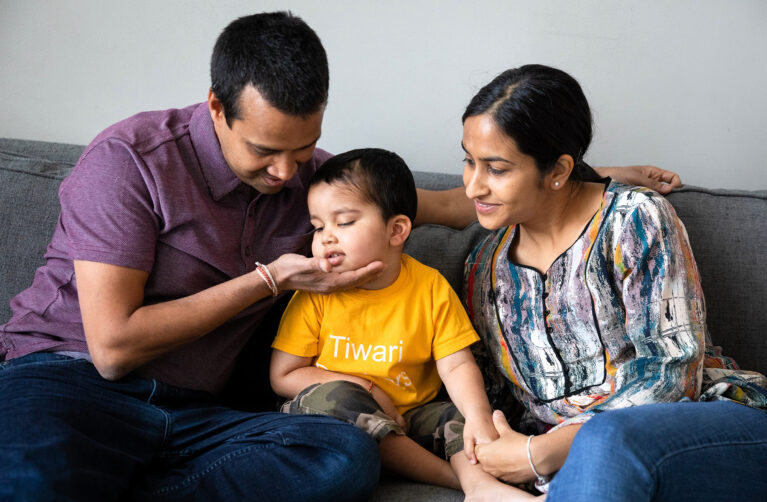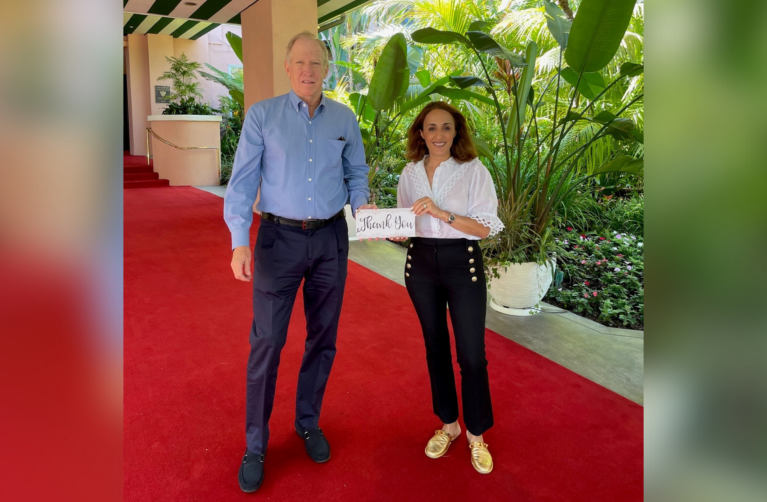For Claire Harding of San Mateo, cancer treatment was life saving – and life changing. Just days before her tenth birthday, she was diagnosed with medulloblastoma, a malignant brain tumor. After surgery to remove the tumor, six weeks of radiation to her head and spine, and a year of chemotherapy, Claire was cancer free. That was more than 10 years ago.
Today, Claire is a junior at Samuel Merritt University, studying to become a nurse – a career choice, she says, that is a direct result of her childhood experience. “Nurses were a constant part of my life,” she recalls.
Despite missing most of fourth and fifth grade, Claire stayed current with her studies by attending the Packard Children’s Hospital School, where she received private tutoring to complete her assignments each week. Today, at age 20, aside from receiving extra time to take tests, Claire has no other learning issues.
But her treatments have left their mark on her physically. She suffers from high frequency hearing loss, a mild eye disorder, hypothyroidism, and nerve damage in her ankles, a condition called foot drop. She continues regular physical therapy, takes daily hormone supplements, and wears orthotics in her shoes. But Claire brushes off the severity of her late effects, saying that her cancer was a blessing in disguise. “I am much more empathetic now as a result of my illness,” she says.
Not every survivor of childhood cancer is as lucky as Claire. Many, especially the youngest patients or those who receive the most intensive therapies, have far greater cognitive deficits and physical limitations after treatment. Today, researchers and clincians at Packard Children’s are working tirelessly to minimize these severe late effects.
The Treatment Tightrope
Cancer survivorship has improved dramatically as oncologists began combining available therapies and increasing dosages. But that success has come at a price. More than 70 percent of children who undergo surgery, radiation, or chemotherapy suffer from chronic medical conditions following therapy, a phenomenon called late effects.
“While we were absolutely delighted about the increase in survivorship, it was clearly at a cost,” says Harvey Cohen, MD, PhD, the Deborah E. Addicott-John A. Kriewall and Elizabeth A. Haehl Family Professor in Pediatrics. “I call it the agony of victory – we had cured the child of cancer, but it was an agony because of the late effects.”
Cancer treatment can damage organs and bones; change a child’s body functions, growth, development, moods, feelings, and actions; produce deficits in thinking, learning, and memory; and increase risk of secondary cancers.
“There’s been a lot of progress over the last decade to maximize survival while minimizing toxicity,” says Michelle Monje-Deisseroth, MD, PhD, assistant professor of neurology and neurological sciences.
One of the main approaches is called risk adaptive therapy – an attempt to gauge individual patients’ risk profiles more accurately, and then treat them accordingly. Clinicians can minimize the toxicity of therapy in lower-risk patients, and only give the most intensive therapy to children who are more likely to die from their disease.
In every case, parents are educated about potential late effects and have a say in the treatment their child receives.
Family-Centered Care
When Rosemary and Geoff Walls of Napa brought their 22-month-old son, Luc, to Packard Children’s in 2006, they had spent weeks in and out of doctor’s offices desperate to learn why their toddler had reverted to crawling and was throwing up constantly. Within minutes of entering Stanford’s emergency room, the Walls were looking at results from a portable CT scan, seeing for the first time the golf-ball-sized tumor in their child’s brain.
Luc had an atypical teratoid rhabdoid tumor, which has a less than 10 percent survival rate. “It’s basically the last tumor any parent wants to hear about,” says Luc’s oncologist Paul Fisher, MD, the Beirne Family Professor of
Pediatric Neuro-Oncology.
Because of Luc’s young age, radiation to the entire brain would have devastating cognitive effects. But the Walls had done enough research to know that chemotherapy alone would not do the job. “We knew the circumstances we had to face: a possible handicapped child, or no child,” recalls Geoff. And they pushed for radiation therapy following the surgery.
Luc’s tumor was in the lower part of his brain, so he was treated with conformal radiation to the affected area only, not his entire head. A month of daily radiation pulses was followed by seven months of chemotherapy, including novel drug treatments directly into his spinal fluid.
Today, five years later, Luc remains cancer free. Although he is completely deaf in his left ear and wears a hearing aid in his right, he is bilingual, doing well in school, and beginning to thrive socially. In fact, says his dad, most of his friends and their parents don’t even realize his unique medical history.
Making these difficult treatment decisions is a group affair at Packard Children’s. The hospital belongs to a national consortium of more than 200 children’s hospitals that share the latest information on treatment protocols for the most common childhood cancers. “Through this shared knowledge,” says Cohen, “we’ve learned which drugs to use and how to use them in the safest way possible.”
For children diagnosed with more rare cancers, the Packard Pediatric Tumor Board – a group of pediatric oncologists, radiation oncologists, surgeons, radiologists, and pathologists – meets weekly to review each case and develop a treatment plan. “You have the benefit of a lot of minds here at Packard,” Cohen adds.
Patients for Life
Claire and Luc are just two of the more than 275,000 survivors of childhood cancer in the United States, patients who have a unique medical history that has been forever altered by their treatment. At Packard Children’s, survivors of childhood cancer are followed by their neuro-oncology team or at the Health After Therapy (HAT) clinic.
“Kids still need primary care,” says Fisher. “But in terms of dealing with the bigger health issues that are a direct result of their cancer therapies, they need to be seen by us.”
At annual patient visits, HAT clinical director Arun Rangaswami, MD, and nurse practitioner Verna Mitchell, NP, emphasize wellness. During 60 to 90 minute appointments, they take a medical and social history and individualize their follow-up based on the type of cancer the child had, the type of treatment received, genetic factors, and general health and habits. Patients then receive a timeline of the follow-up care, lab, and surveillance tests they will require on an ongoing basis.
Children who are struggling in school are automatically referred to the Hospital Educational Advocacy Liaisons (HEAL) program, directed by Jeanne Kane. HEAL staff members advocate for medically fragile children, traveling to school sites to educate teachers and students about the late effects of cancer, and attending planning and advocacy meetings with parents and educators.
HEAL’s dedicated neuro-psychologist and educational specialists conduct assessments of childhood cancer survivors to diagnose learning disabilities, and guide any necessary school accommodations or potential symptomatic therapies. For example, stimulants such as methylphenidate (Ritalin) can help patients with impaired information processing, concentration, or attention difficulties, and some dementia medications can help with memory dysfunction.
Rangaswami emphasizes the importance of following cancer survivors for life. “We’ve learned that cancer survival is more than just a feel-good story,” he says. “Every choice we make as care providers has a profound effect on our patients and their families.”



